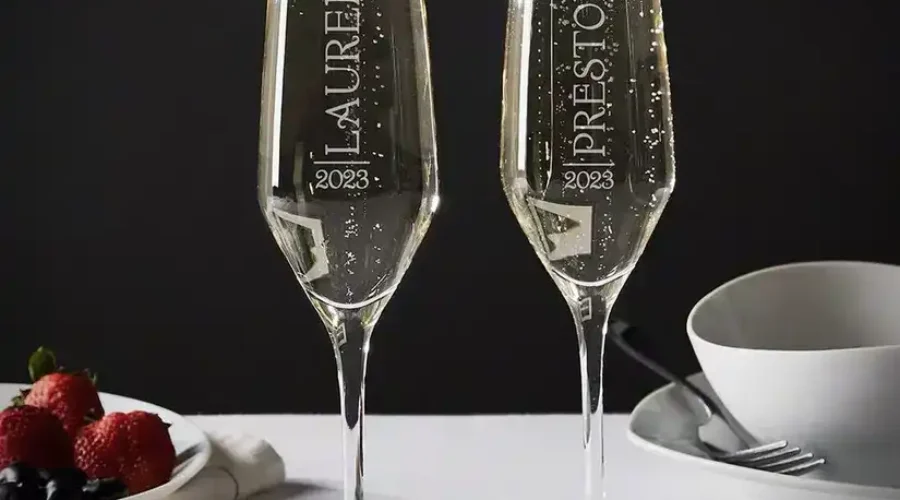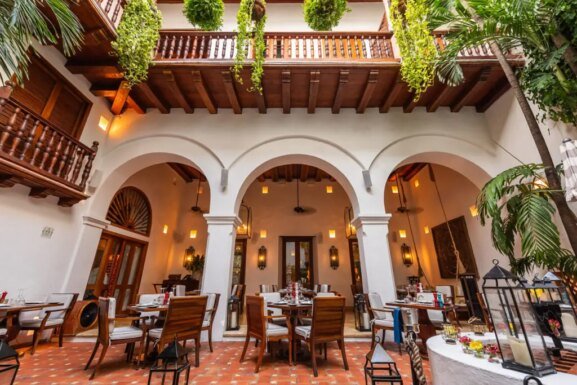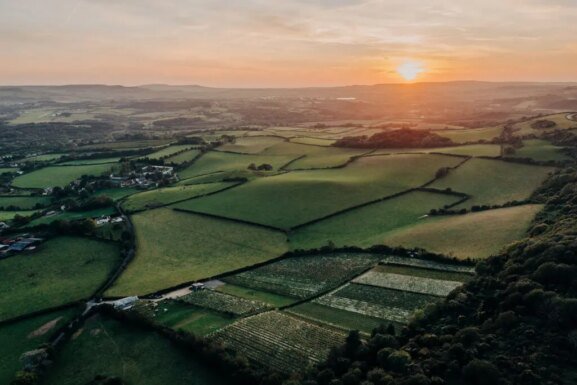How the Late ‘Johnny Cash of English Wine’ Changed British Bubbles Forever
Author’s Note: On Wednesday, October 2nd 2025, one of English wine’s most treasured and pioneering winemakers, Peter Hall of Breaky Bottom, died at the age of 82. Peter was a vigneron in the truest sense of the word. He lived for 51 years in his verdant burrow of the South Downs, tending to his vines and making sparkling wines on site, primarily from a widely derided variety that, in his care, was transformed into something unique, utterly delicious, and unbelievably age-worthy.
Rebellious, passionate, and highly cultured yet rough-around-the-edges, Peter was, as fellow winemaker Dermot Sugrue once described him, “the Johnny Cash of English wine and a legend in his own life jacket.”
I had the great fortune to visit Peter in April 2024, and it remains an afternoon that I will never forget. I wrote the following piece shortly afterwards for Wine Enthusiast’s print pages and I’m thrilled to share it here—a fitting tribute, I hope, for a man who had such an impact on English wine.
“Do you mind if I swear?”
“I’m a New Yorker,” I reply. “Swear away.”
This is how my afternoon with Peter Hall, England’s longest serving winemaker and grower—and the proprietor of the celebrated Breaky Bottom winery in southeast England—begins. It’s a cool, late April day and we’re seated in old armchairs by the back door to the garden of Hall’s remotely located 19th-century farmhouse.
In addition to cussing, Hall, who turned 81 the Sunday before (on the late Queen’s birthday, no less), asks politely whether I mind if he smokes the hand-rolled cigarettes he’s been addicted to for longer than the 50 years he’s been tending the vines in this small, idyllic fold of the South Downs. (I dare not refuse him.) And now I understand that our position by the back door is more for ventilative purposes than to provide me a view of these same vines peeking above the garden’s stone wall, just days from bud burst.
“One has to confront what is,” Hall tells me sagely. “Today we have lost our cat. We had a cat called Toto for 17 years, and this morning, where is he? We’ve looked in every single building, every paddock. I’m very distracted.”
I suspect distraction is part and parcel of Hall’s personality. In addition to being devoted to the creatures in his care, whether flora, fauna or feline, Hall is a deep thinker; he’s a man who dives down fascinating (if sometimes hard-to-follow) philosophical rabbit holes. A self-declared hermit, Hall is tall and, these days, frail. His skeletal frame dons a wool flat cap, blue sailor-striped shirt and well-worn jacket with a flash of red socks between his blue jean cuffs and workman’s boots—a uniform he’s worn in some iteration for decades.
The Beginning of Breaky Bottom
Hall’s reign as one of England’s most revered winemakers was earned not by squeezing into a specific mold, but because he refuses to do so. In a country where Pinot Noir and Chardonnay-based méthode Champenoise are putting the region on the world wine map, this man’s legacy, instead, is built upon the unloved French hybrid variety Seyval Blanc, which he produced as a bone-dry table wine in the last decades of the 20th century in stark contrast to mostly semi-sweet and largely underripe and underwhelming expressions that dominated English wine at the time. While today Hall, like his modern counterparts, focuses on fizz, Seyval Blanc remains the dominant variety, and his calling card. Vines were not, however, initially Breaky Bottom’s bottomline business.
Breaky Bottom (an ancient name for the valley mentioned in the 1086 Domesday Book, not, as visitors today might assume, a reference to the damage inflicted upon vehicles traversing the unpaved, bone-rattling track that is the only way in and out of the property) was initially “an old-fashioned mixed farm” with pigs, sheep, chickens, geese and turkeys. When Hall first settled into his farmhouse in 1967, a newly earned agriculture degree in hand and a newfound love for the solitude and dramatic landscape of England’s chalky spine, he’d been hired as a farmhand for the surrounding property, called Northease Farm. He lived in it for three years without electricity or indoor plumbing until being offered a tenancy. Hall eventually married the Northease farmer’s daughter, Diana, purchased 15 acres of the land at a nail-biting auction and continued his tenancy of another 15 acres, which remains the arrangement today.
// Create the element
var script_68e43bc63d542 = document.createElement(“script”);
script_68e43bc63d542.innerHTML = `
window.googletag = window.googletag || {cmd: []};
googletag.cmd.push(function() {
var adType = “leaderboard”;
var mapping;
var lbmapping = googletag.sizeMapping()
.addSize([1024, 0], [[970, 250], [970, 90], [1, 1], [728, 90]])
.addSize([728, 0], [[728, 90], [1, 1]])
.addSize([320, 0], [[1, 1], [300, 50], [300, 100], [320, 50], [320, 100]])
.addSize([0, 0], [[1, 1], [320, 50]])
.build();; // Size mapping for leaderboard ads
var medrecmapping = googletag.sizeMapping()
.addSize([1024, 0], [[300, 600],[300, 250]])
.addSize([728, 0], [300, 250])
.addSize([320, 0], [[1, 1],[300, 250]])
.addSize([0, 0], [[1, 1], [300, 250]])
.build(); // Size mapping for med rectengle ads
if(‘/39808611/article_page/article_leaderboard_1’ == ‘/39808611/article_page/article_leaderboard_1’
|| ‘/39808611/article_page/article_leaderboard_1’ == ‘/39808611/article_page/article_leaderboard_2’
|| ‘/39808611/article_page/article_leaderboard_1’ == ‘/39808611/article_page/article_leaderboard_3’) {
mapping = googletag.sizeMapping()
.addSize([1920, 0], [[728, 90]]) // >= 1920px
.addSize([1440, 0], [[728, 90]]) // 1440px-1919px
.addSize([730, 0], [[300, 250]]) // 730px-1439px
.addSize([0, 0], [[320, 100], [320, 50], [300, 100], [300, 50], [300, 250]]) // Up to 729px
.build();
} else {
mapping = adType == ‘leaderboard’ ? lbmapping : medrecmapping;
}
googletag.defineSlot(‘/39808611/article_page/article_leaderboard_1’, [],
‘div-gpt-ad-68e43bc63d542’).addService(googletag.pubads()).defineSizeMapping(mapping);
googletag.pubads().enableSingleRequest();
googletag.pubads().collapseEmptyDivs();
googletag.display(‘div-gpt-ad-68e43bc63d542’);
});
`;
// Append the script to the body
document.body.appendChild(script_68e43bc63d542);
But wine was a longtime love of Hall’s, fostered by his French grandfather who owned a once-renowned restaurant in London’s Soho neighborhood called Le Petit Savoyard pre-WWI. “He never made any money, but he was a brilliant cook and had a cellar second to none,” Hall tells me after several aforementioned rabbit holes. “[He] taught us as kids to respect the label. And after that, he would clap his hands and say, ‘Anyway, children, it’s only fermented grape juice. So you’ve looked at the label, you’ve acknowledged that, but now it’s up to you. What do you think of it?’ He taught us a lot.”
Anyway, children, it’s just fermented grape juice.
Peter Hall
Hall eventually sold off the livestock. (Except the sheep; he derives great pleasure from their company and shortly after my visit was “off to bottle-feed a little lambkin.”) In April 1974, 50 years to the month before my visit, Hall planted two acres of north-facing Seyval Blanc and two of the Germanic variety Müller-Thurgau beside the farmhouse, joining the ranks of just a handful of vignerons in England at the time. “There were very few wines available. [English] Müller Thurgau was bloody awful,” Hall says, deftly rolling another cigarette.
But in Hall’s hands—and from his suntrap of a valley, protected from harsh coastal winds and frosts—Breaky Bottom’s Müller-based wines of the 1980s and ’90s tasted, according to wine writer Oz Clarke OBE, “peppery, leafy, crackling with grapefruit tang—and delicious.”
In 2002, Hall planted two more acres of Seyval, but replaced the Müller with Chardonnay, Pinot Noir and Pinot Meunier. His focus is now entirely on sparkling. These days, Breaky Bottom annually releases just two cuvées, aged on lees for at least four years. His total production is just 10,000 bottles, and that’s if the weather cooperates, which, in England, is only on occasion, even in this sheltered valley.
A British Bubbles Legend
After some deliberation, Hall requests bottles from Louisa Adams, his first and only employee since 2018, who has been popping in and out of our conversation, gently nudging Hall back on subject after a tangent. She returns with three bottles: a 2010 Brut and two sparkling Seyval Blancs from the 2016 and 2010 vintages. They’re named, like all of Hall’s cuvées, after people who have influenced him in some way—woodworkers, cartoonists, conductors, the young man who mowed his lawn.
The 2016 Cuvée Marraine Pooks is named for his French godmother, Helen Burke, a famous food critic who pioneered food photography; the 2010 Cuvée Koizumi Yakumo references Hall’s great great-uncle, a newspaper writer who moved to Japan and taught the West about Japanese culture; and the 2010 Brut Cuvée Reynolds Stone, a famous British wood engraver.
// Create the element
var script_68e43bc63d990 = document.createElement(“script”);
script_68e43bc63d990.innerHTML = `
window.googletag = window.googletag || {cmd: []};
googletag.cmd.push(function() {
var adType = “leaderboard”;
var mapping;
var lbmapping = googletag.sizeMapping()
.addSize([1024, 0], [[970, 250], [970, 90], [1, 1], [728, 90]])
.addSize([728, 0], [[728, 90], [1, 1]])
.addSize([320, 0], [[1, 1], [300, 50], [300, 100], [320, 50], [320, 100]])
.addSize([0, 0], [[1, 1], [320, 50]])
.build();; // Size mapping for leaderboard ads
var medrecmapping = googletag.sizeMapping()
.addSize([1024, 0], [[300, 600],[300, 250]])
.addSize([728, 0], [300, 250])
.addSize([320, 0], [[1, 1],[300, 250]])
.addSize([0, 0], [[1, 1], [300, 250]])
.build(); // Size mapping for med rectengle ads
if(‘/39808611//39808611/article_page/article_leaderboard_2/article_leaderboard_2’ == ‘/39808611/article_page/article_leaderboard_1’
|| ‘/39808611//39808611/article_page/article_leaderboard_2/article_leaderboard_2’ == ‘/39808611/article_page/article_leaderboard_2’
|| ‘/39808611//39808611/article_page/article_leaderboard_2/article_leaderboard_2’ == ‘/39808611/article_page/article_leaderboard_3’) {
mapping = googletag.sizeMapping()
.addSize([1920, 0], [[728, 90]]) // >= 1920px
.addSize([1440, 0], [[728, 90]]) // 1440px-1919px
.addSize([730, 0], [[300, 250]]) // 730px-1439px
.addSize([0, 0], [[320, 100], [320, 50], [300, 100], [300, 50], [300, 250]]) // Up to 729px
.build();
} else {
mapping = adType == ‘leaderboard’ ? lbmapping : medrecmapping;
}
googletag.defineSlot(‘/39808611//39808611/article_page/article_leaderboard_2/article_leaderboard_2’, [],
‘div-gpt-ad-68e43bc63d990’).addService(googletag.pubads()).defineSizeMapping(mapping);
googletag.pubads().enableSingleRequest();
googletag.pubads().collapseEmptyDivs();
googletag.display(‘div-gpt-ad-68e43bc63d990’);
});
`;
// Append the script to the body
document.body.appendChild(script_68e43bc63d990);
Adams pours us each a taste. “Do you promise, Christina, that you’ll shoot from the hip? Tell me how you feel about [the wines]. I like criticism.” I promise.
But after tasting all three, it’s hard to find much to criticize. The Brut, made from younger Pinot and Chardonnay vines, is the most opulent, with bright lemony acidity. It’s delicious, I tell Hall, but it’s not like the Seyvals, which truly exude a sense of place: They could come from nowhere but this unique pocket of East Sussex. The 2010 Seyval is particularly gorgeous, weaving green citrus with honeyed, toasty brioche and spice. It’s startlingly fresh for its age, beautifully long and complex. “I like to age my wines longer,” says Hall, putting his glass down and rolling yet another cigarette.
Five Decades of Greatness
Hall is steadfast. He’s had to be. Over the past five decades, Breaky Bottom’s vines have been ravaged by flocks of ravenous birds, flooded five times and he’s been flat broke more than once. Now, with his wife ill and his own mortality looming, the future of Breaky Bottom is uncertain. None of Hall’s four children or two stepchildren shows interest in continuing the legacy of his life’s work. Adams, while clearly devoted, doesn’t have the capital. When I ask Hall about this, he admits he’s had interested buyers “poking around.” He jokes sadly about rich Londoners “who earn silly money” who’d be willing to pay a large sum to “rip out the vines and put in a helicopter pad.”
“You wouldn’t sell to someone like that, would you?” I ask.
“Well, who do you want, another bearded old codger? This place will likely have to be sold, but I’ll fight tooth and nail to stay here as long as I can,” he answers.
For many, it’s hard to imagine a world without Peter Hall and Breaky Bottom.
For many, it’s hard to imagine a world without Peter Hall and Breaky Bottom. Those who have visited this verdant burrow over the decades understand its magic. And now I understand it, too.
Before I depart, Adams offers me a tour of the adjacent winery and cellar. Upon entering, we hear a loud meowing coming from behind the cellar door. We open it to find Toto the cat anxiously awaiting rescue. We rush back to the farmhouse to return him. Hall’s relief is palpable and I am unexpectedly moved. Maybe it’s the beauty of the place, or the man who tends to it or the effect of the wines themselves. I suspect it’s a bit of everything. Breaky Bottom’s future might be uncertain, but—at least for today—there is a happy ending.
A version of this article originally appeared in the Best of Year 2024 issue of Wine Enthusiast magazine. Click here to subscribe today!
More British Wine and Spirits Coverage
- Where to stay in England if you love wine.
- Drink like a king with these British royal-approved brands.
- Insider the radical transformation of London’s wine scene.
- How British gin producers are dealing with the decline of juniper.
- Meet more of the winemakers behind English sparkling wine boom.
In the Shop
Find a Glass for Every Sparkling Moment
The post How the Late ‘Johnny Cash of English Wine’ Changed British Bubbles Forever appeared first on Wine Enthusiast.


